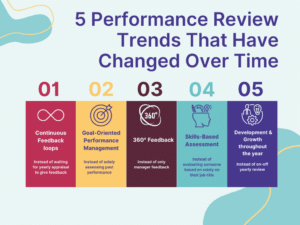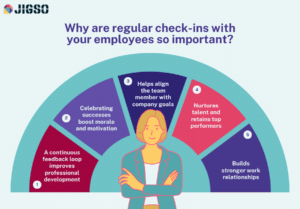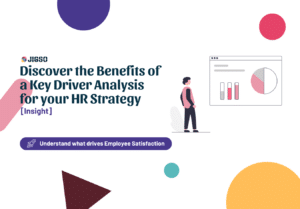Read the full article below or download the pdf.

Impact of employee absenteeism
Unplanned employee absenteeism is undoubtedly a significant cost driver for any business. It is also something that can be very difficult to measure the true cost of. The direct costs — things like wages, administrative workload, and so on — may be relatively simple to measure and forecast. However, the indirect costs — for example reduced employee morale from understaffing, reduced productivity, and the greater burdens on HR departments — can easily be overlooked. Beyond this, if not addressed properly, unplanned absenteeism can even affect the way that key stakeholders perceive your company, having knock-on impacts on your bottom line in a range of negative ways.
For these reasons and more, businesses across all industries are increasingly devoting significant resources to combat their internal issues with unplanned absenteeism. One of the most popular ways to approach this is to analyze HR-sourced employee data to try and gain useful insights into the workforce.
Unfortunately, this type of approach has some common limitations. For example, the statistical relevance of the insights is often insufficient to convince C-Suite members to commit appropriate funding. Additionally, the task of scanning through extensive databases and performing complex statistical analyses can be offputting for HR personnel and may seem too detached from the frontline HR tasks of working directly with staff.
So, how should organizations ensure that HR departments are equipped with the necessary tools to access valuable insights, gain bargaining power with the C-Suite, and become more effective? We believe that the solution lies in advanced people analytics.
What is People Analytics?
The use of data in Marketing
Perhaps the best way to introduce anybody to the world of people analytics is to use the analogy of marketing. Prior to the 21st Century, the field of marketing was regularly stuck in the ‘one-ad-fits-all’ mentality, where advertisements were designed for mass appeal and distributed via the medium with the widest immediate reach. In essence, this methodology focused on forcing as many people as possible directly to the ‘action’ segment of the marketing funnel in the hope that it would boost sales.
In more recent years, with the advent of the internet and ever-advancing computing power, the marketing funnel has undergone a rapid and transformative evolution. This new marketing funnel is vastly more efficient and, importantly, more targeted. By ultra-focusing marketing efforts to carefully identified niches, companies can now almost guarantee high levels of conversions for a lower investment than ever before. Now, customers are neatly guided through the funnel by being offered the right content and the right time, making them far more inclined to play ball. In addition, the ever-present influx of data now enables marketing departments to identify and track KPIs, gain actionable insights, and influence the C-Suite more readily.
The use of data in HR
This marketing revolution has been driven by one thing — data. By recognizing the power of data, marketing teams worldwide have found ways to get more for their money, but HR departments are still largely reluctant to adapt in the same way by putting their data to work. Group-level learning and development, standardized compensation and benefits schemes and generalized absenteeism programs are still the go-to solution for most HR departments. While they are sometimes effective, relying solely on these methods is undeniably an outdated strategy, particularly when one takes into account the vast amounts of revealing data now at these departments’ fingertips.
People analytics is about trying to evoke the relevance of these concepts on a wide scale, and convincing the world of business that data science and its companion technologies are inherently adaptable, and have an important role to play across HR departments.
The four levels of business analytics
The versatility of analytics is well illustrated by Gartner’s Analytic Value Escalator framework, which subdivides business analytics into four levels:
1. DESCRIPTIVE ANALYTICS: answers the question ‘What has happened?’
2. DIAGNOSTICS ANALYTICS: answers the question ‘Why did it happen?’
3. PREDICTIVE ANALYTICS: answers the question ‘What will happen?’
4. PRESCRIPTIVE ANALYTICS: answers the question ‘How can we make it happen?’
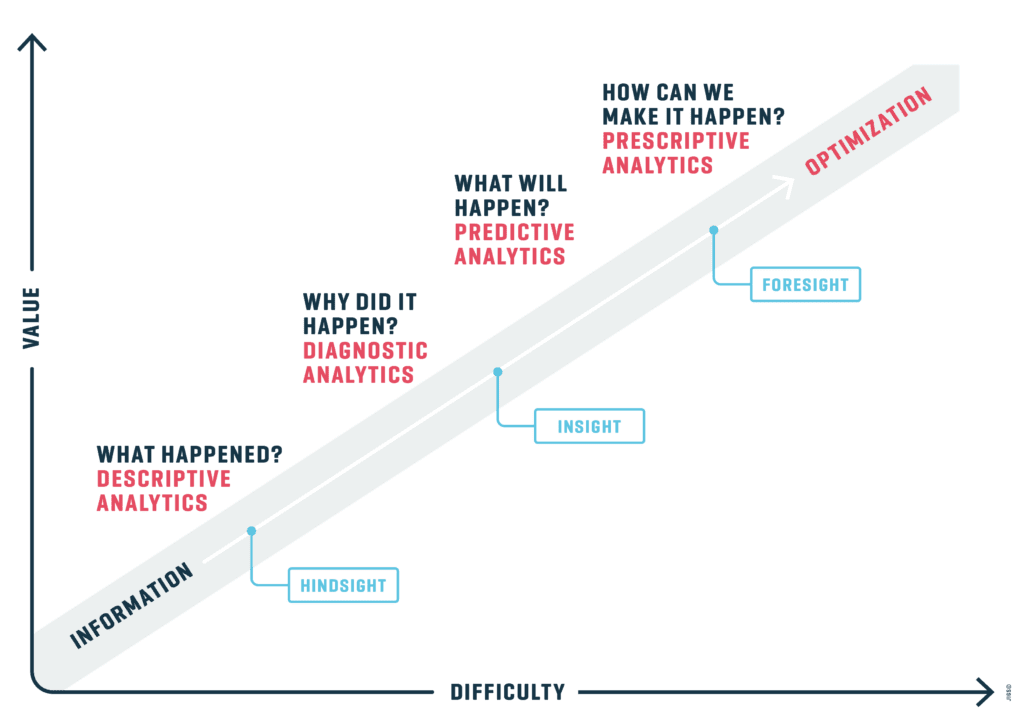
Even the HR departments that already do utilize analytics are still generally confined to the lower left-hand corner of the Analytic Value Escalator. People analytics aims to gradually shift their behaviour up the ladder, culminating with predictive and prescriptive analytics.
How to reduce absenteeism with people analytics
Our client’s challenge
A JiGSO client — a major player in the cleaning services field — had been experiencing ongoing issues with spiraling absenteeism. The company operated on a large scale, with more than 2,000 cleaning staff deployed daily, so the financial impact of this absenteeism was significant. At this scale, a reduction of absenteeism of just 0.1% was able to increase gross margins by €50,000, making it an important area of investment.
The nature of the company’s work dictated that cleaning staff spent the majority of their time at client’s properties, unable to be supervised. This meant that HR struggled to collect relevant data and build absenteeism risk profiles in the traditional way. To get around this limitation, they were forced to rely on aggregated payroll data and individual character evaluations in an effort to determine how they should target their efforts, which resulted in sub-optimal insights.
The solution
JiGSO was brought in to provide HR consultancy, mathematical modeling, and data analytics expertise to help overcome these issues and provide clear, actionable insights.
The JiGSO team immediately recognized the need for a secure data exchange pipeline, involving an experienced selection of data engineers, data scientists, and mathematicians who could take ownership of the data strategy. The new improved strategy was centered around two key areas:
- Payroll data: comprised out of day-to-day and monthly aggregated data regarding the working hours, absenteeism hours, and reason for absenteeism for each individual employee.
- Employee-specific data: including personal data such as demographics, marital status, number of different clients, and wages for each individual. The use of these enriched and highly specific datasets helped the JiGSO team to experiment constructively with various complex forecasting models and statistical methods.
As is often the case, a number of the simpler, more intuitive models were found to perform most effectively. The JiGSO team also discovered that critical insights could be derived from just a few previously overlooked parameters. These parameters were mostly related to absenteeism patterns, the Bradford frequency, and the number of absenteeism days, among others.
From these critical insights, the team managed to build and deploy a powerful predictive model capable of automatically collecting and processing large datasets to provide a monthly list of employees at high-risk for absenteeism. Beyond this, the established data processing pipeline was able to generate informative graphs and reports to help HR personnel track absenteeism history and metrics of each individual employee (Fig. 2)
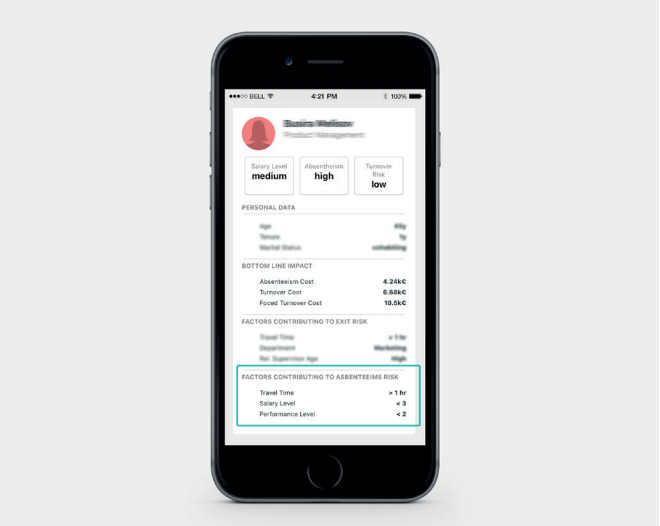
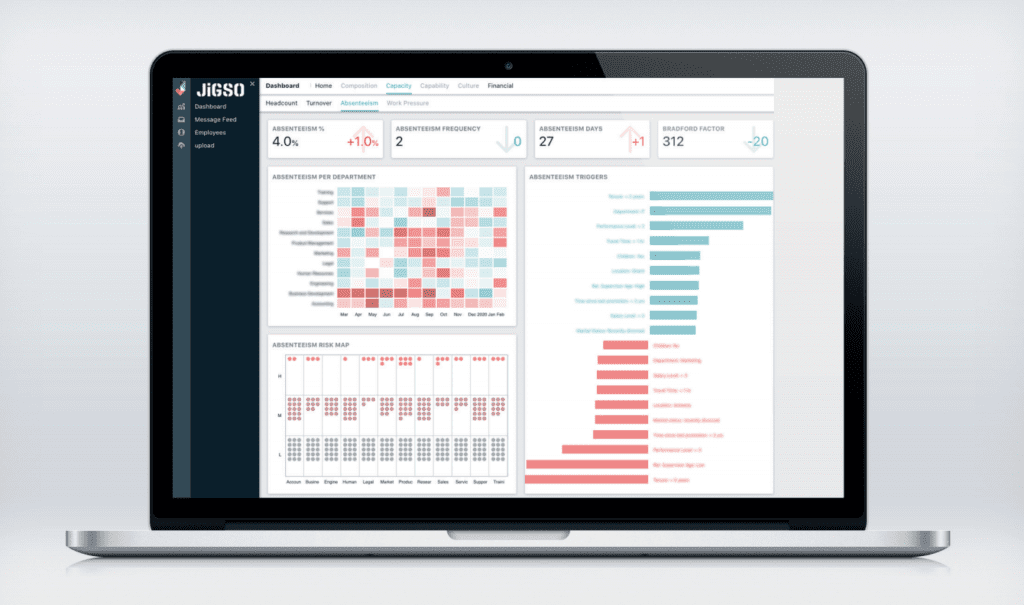
The result
Once the model was established, the JiGSO team acted to validate its usability. To do this, the monthly shortlists were compared with the client’s own internally generated lists. The new algorithm was proven to significantly outperform the old, helping to highlight many more high-risk individuals and produce a greater volume of useful insights.
But how did JiGSO’s work affect the current HR-practices for this client? The company has now bypassed the need to go through extensive spreadsheets to find information about employees at high risk of absenteeism. The new JiGSO engine provides a comprehensive and easily understandable readout of critical cases, saving HR’s limited resources for more pressing workforce matters. Armed with targeted and actionable insights, the client’s HR department is now capable of taking effective preventative measures to reduce absenteeism, acting proactively rather than reactively to tackle this common and resource-intensive issue.

